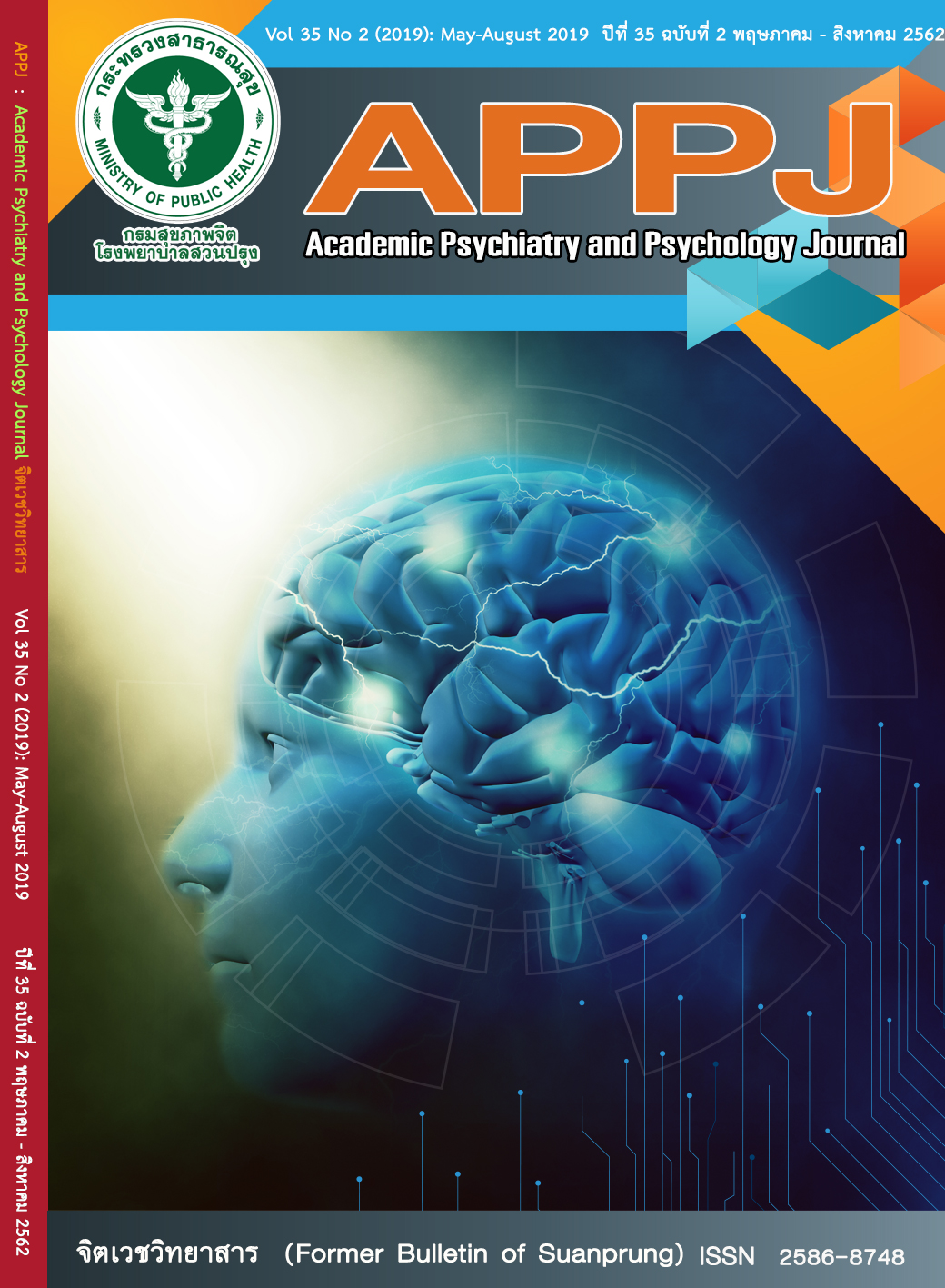The Development of Chiang Mai Amphetamine Craving Questionnaire ( CACQ)
Main Article Content
บทคัดย่อ
วัตถุประสงค์ เพื่อศึกษาแบบวัดอาการอยากยา ในผู้ติดแอมเฟตามีน
วิธีการศึกษา ศึกษาอาการอยากยาผู้ป่วยในศูนย์บำบัดรักษายาเสพติดขอนแก่น จำนวน 38 คน ช่วงสิงหาคม 2555 ถึง กรกฎาคม 2556 โดยวิธีการของ Cooney et al (1997) อาศัยวีดิทัศน์ เพื่อกระตุ้นให้กลุ่มตัวอย่างมีอาการอยากยา แล้ววัดระดับ Cortisol และทำแบบประเมินอาการอยากยา Chiang Mai Amphetamine Craving Questionnaire (CACQ) , Visual Analogue Scale of Craving (VAS), State-trait Anxiety Inventory (STAI) รวมไปถึงการเปลี่ยนแปลงสัญญาณชีพ ก่อนและหลังการดูวีดิทัศน์สถิติที่ใช้หา Internal Consistency ของ CACQ ด้วย Cronbach’s alpha coefficient = 0.78 การหา Validity ของแบบวัด 1) Construct Validity : ข้อมูลการเปลี่ยนแปลง CACQ กับ STAI, VAS2) concurrent Validity : คะแนน CACQ เทียบกับการเปลี่ยนแปลงสัญญาณชีพ และ Serum cortisol 3) Discriminant Validity ข้อมูล CACQ กับ STAI, VAS โดยค่าสัมประสิทธิ์สหสัมพันธ์ ใช้ที่ระดับ r >0.5
ผลการศึกษา การกระตุ้นอาการอยากยาด้วย Cue ในวิธีนี้ สามารถกระตุ้นให้เกิดอาการอยากยาได้ จากแบบวัด VAS และ CACQ 1) Construct Validity แบบประเมิน CACQ นี้ ไม่มีความเที่ยงตรงเชิงโครงสร้าง เมื่อเทียบกับแบบประเมิน VAS และ STAI 2) ไม่พบ concurrent validity ที่มีนัยสำคัญ ระหว่าง CACQ กับผลการตรวจสัญญาณชีพระหว่างการถูกกระตุ้นให้เกิดความรู้สึกอยากยา ยกเว้น ผลต่างของอัตราการเต้นของหัวใจขณะดูวีดิทัศน์ มีค่า r = -0.360 p-value = 0.021 3) Discriminant Validity ไม่พบการเปลี่ยนแปลงอย่างมีนัยสำคัญทางสถิติ
สรุป แบบวัด CACQ ยังไม่สามารถนำมาใช้วัดอาการอยากยาได้ แต่การศึกษานี้ พบว่า อาการอยากยานั้น อาจไม่เกิดร่วมกับการเปลี่ยนแปลงสัญญาณชีพ หากเป็นความรู้สึกนึกคิดเท่านั้น
คำสำคัญ แบบวัด, อาการอยากยา, แอมเฟตามีน
Article Details
บทความหลังผ่านการปรับแก้จากกองบรรณาธิการแล้ว เป็นลิขสิทธ์ของวารสารจิตเวชวิทยาสาร โรงพยาบาลสวนปรุง กรมสุขภาพจิต กระทรวงสาธารณสุข ห้ามเผยแพร่เพื่อประโยชน์ทางการค้าโดยไม่ได้รับอนุญาต แต่อนุญาตให้เผยแพร่บทความดังกล่าวเพื่อประโยชน์ทางการศึกษาแก่ประชาชนทั่วไป ทั้งนี้กองบรรณาธิการไม่จำเป็นต้องเห็นด้วยกับบทความหรือข้อคิดเห็นใดๆ ที่ปรากฏในวารสารสวนปรุง
เอกสารอ้างอิง
2. Fleckenstein AE, Hanson GR. Impact of psychostimulants on vesicular monoamine transporter function. Eur J Pharmacol. 2003 Oct 31;479(1-3):283-9.
3. Bhakthavatsalam P, Kamatchi GL, Ghosh MN. Tolerance pattern to amphetamine
anorexia after selective lesions in the hypothalamic dopaminergic projection. Life Sci.1985 Aug 19;37(7):635-43.
4. Wolgin DL, Hughes KM. Long-term retention of tolerance to amphetamine hypophagia following cessation of drug injections and feeding tests.Pharmacol Biochem Behav. 2001 Oct-Nov;70(2-3):367-73.
5. Gilpin NW, Koob GF. Neurobiology of alchohol dependence.Alcohol Res Health.
2008;31(3): 185-95.
6. Carter BL, Tiffany ST. Meta-analysis of cue-reactivity in addiction research. Addiction. 1999.94 Mar;94(3):327-40.
7. Tiffany ST. Cognitive concept of craving.Alcohol Res Health. 1999;23(3):215-24.
8. Childress AR, Ehrman R, McLellan AT, MacRae J, Natale M, O'Brien CP.Can induced moods trigger drug-related responses in opiate abuse patients. J Subst Abuse Treat. 1994 Jan-Feb;11(1):17-23.
9. Litt MD, Cooney NL, Kadden RM, Gaupp L. Reactivity to alcohol cues and induced moods in alcoholics. Addict Behav. 1990;15(2):137-46.
10. Kirschbaum C, Prüssner JC, Stone AA, Federenko I, Gaab J, Lintz D, et al. Persistent high cortisol responses to repeated psychological stress in a subpopulation of healthy men.Psychosom Med. 1995 Sep-Oct;57(5):468-74.
11. Kalivas PW,Volkow ND.The neural basis of addiction: a pathology of motivation and choice.Am J Psychiatry. 2005 Aug;162(8):1403-13.
12. Shalev U, Grimm JW, Shaham Y. Neurobiology of relapse to heroin and cocaine
seeking: a review.Pharmacol Rev. 2002 Mar;54(1):1-42.
13. Rawson RA, Huber A, Brethen P, Obert J, Gulati V, Shoptaw S, et al. Status of
methamphetamine users 2-5 years after outpatient treatment. J Addict Dis. 2002;
21(1):107-19.
14. Paliwal P, Hyman SM, Sinha R. Craving predicts time to cocaine relapse: further
validation of the now and brief versions of the cocaine craving questionnaire.Drug
Alcohol Depend. 2008 Mar 1;93(3):252-9.
15. Cooney NL, Litt MD, Morse PA, Bauer LO, Gaupp L. Alcohol cue reactivity, negative-mood reactivity, and relapse in treated alcoholic men. J Abnorm Psychol. 1997 May;106(2):243-50.
16. Widiger TA, Frances AJ, Pincus HA, Ross R, First MB, Davis WW, editors. DSM-IV sourcebook, vol.3. Washington, DC: American Psychiatric Association; 1997
17. Sheehan DV, Lecrubier Y, Sheehan KH, Amorim P, Janavs J, Weiller E, et al. The
Mini-International Neuropsychiatric Interview (M.I.N.I.): the development and validation of a structured diagnostic psychiatric interview for DSM-IV and ICD-10. J Clin Psychiatry. 1998;59 Suppl 20:22-33;quiz 34-57.
18. Nasreddine ZS, Chertkow H, Phillips N, et al. The Montreal Cognitive Assessment
(MoCA): a brief cognitive screening tool for detection of mild cognitive impairment.
Neurology.2004;62(5):A132.
19. Spielberger CD, Gorsuch RL. Manual for the State-Trait Anxiety Inventory STAI (form Y): Self-evaluation questionnaire. Palo Alto, CA: Consulting Psychologist Press; 1983.
20. Thapinta D. Reduction of anxiety of staff nurses working with AIDS patients through Cognitive reconstructuring and mindfulness training [Thesis Ph.D.] Bangkok: Chulalongkorn University; 1991. (in Thai)
21. Napassorn R, et al. Effective of discharge planning in amphetamine dependence
patient at Chiang Mai Drug Dependence Treatment Center. Chiang Mai: Research
Report of Chiang Mai Drug Dependence Treatment Center; 2011. (in Thai)

